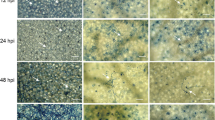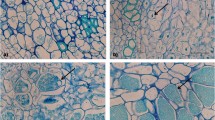Abstract
Cucurbit bacterial wilt, caused by Erwinia tracheiphila, is a devastating disease of cucurbit crops in the Midwest and Northeast U.S. Current management of bacterial wilt relies primarily on insecticide applications to control striped and spotted cucumber beetles (Acalymma vittatum and Diabrotica undecimpunctata howardi, respectively), which vector E. tracheiphila. Development of alternative management strategies is constrained by a lack of understanding of bacterial wilt etiology. The impact of host age on rate on symptom development and extent of bacterial movement in the xylem of muskmelon (Cucumis melo cv. Athena) was evaluated following wound inoculation of 2- to 8-week-old plants in growth chamber experiments. Wilting occurred more rapidly in plants after inoculating E. tracheiphila into 2- or 4-week-old plants than 6- or 8-week-old plants. Recovery of viable cells from stem segments revealed that vascular spread of E. tracheiphila was more extensive below than above the inoculation point. These findings provide experimental evidence that host age impacts the rate of symptom development in cucurbit bacterial wilt and that movement of the xylem-inhabiting pathogen E. tracheiphila within muskmelon plants occurs primarily in the downward direction.

Similar content being viewed by others
References
Ayers, A. R., Ayers, S. B., & Goodman, R. N. (1979). Extracellular polysaccharide of Erwinia amylovora: A correlation with virulence. Applied and Environmental Microbiology, 38, 659–666.
Bahar, O., De la Fuente, L., & Burdman, S. (2010). Assessing adhesion, biofilm formation and motility of Acidovorax citrulli using microfluidic flow chambers. FEMS Microbiology Letters, 312, 33–39.
Beck von Bodman, S., Majerczak, D. R., & Coplin, D. L. (1998). A negative regulator mediates quorum-sensing control of exopolysaccharide production in Pantoea stewartii subsp. stewartii. Proceedings of the National Academy of Sciences of the United States of America, 95, 7687–7692.
Brust, G. E. (1997a). Differential susceptibility of pumpkins to bacterial wilt related to plant growth stage and cultivar. Crop Protection, 16, 411–414.
Brust, G. E. (1997b). Seasonal variation in percentage of striped cucumber beetles (Coleoptera: Chrysomelidae) that vector Erwinia tracheiphila. Environmental Entomology, 26, 580–584.
Cavanagh, A., Hazzard, R., Adler, L. S., & Boucher, J. (2009). Using trap crops for control of Acalymma vittatum (Coleoptera: Chrysomelidae) reduces insecticide use in butternut squash. Journal of Economic Entomology, 102, 1101–1107.
de Mackiewicz, D., Gildow, F. E., Blua, M., Fleischer, S. J., & Lukezic, F. L. (1998). Herbaceous weeds are not ecologically important reservoirs of Erwinia tracheiphila. Plant Disease, 82, 521–529.
Fleischer, S. J., de Mackiewicz, D., Gildow, F. E., & Lukezic, F. L. (1999). Serological estimates of the seasonal dynamics of Erwinia tracheiphila in Acalymma vittata (Coleoptera : Chrysomelidae). Environmental Entomology, 28, 470–476.
Garcia-Salazar, C., Gildow, F. E., Fleischer, S. J., Cox-Foster, D., & Lukezic, F. L. (2000). Alimentary canal of adult Acalymma vittata (Coleoptera : Chrysomelidae): Morphology and potential role in survival of Erwinia tracheiphila (Enterobacteriaceae). Canadian Entomologist, 132, 1–13.
Herrera, C. M., Koutsoudis, M. D., Wang, X. L., & von Bodman, S. B. (2008). Pantoea stewartii subsp. stewartii exhibits surface motility, which is a critical aspect of Stewart's wilt disease development on maize. Molecular Plant-Microbe Interactions, 21, 1359–1370.
Holland, R. M., Christiano, R. S. C., Gamliel-Atinsky, E., & Scherm, H. (2014). Distribution of Xylella fastidiosa in blueberry stem and root sections in relation to disease severity in the field. Plant Disease, 98, 443–447.
Ionescu, M., Zaini, P. A., Baccari, C., Tran, S., da Silva, A. M., & Lindow, S. E. (2014). Xylella fastidiosa outer membrane vesicles modulate plant colonization by blocking attachment to surfaces. Proceedings of the National Academy of Sciences of the United States of America, 111, E3910–E3918.
Koutsoudis, M. D., Tsaltas, D., Minogue, T. D., & von Bodman, S. B. (2006). Quorum-sensing regulation governs bacterial adhesion, biofilm development, and host colonization in Pantoea stewartii subspecies stewartii. Proceedings of the National Academy of Sciences of the United States of America, 103, 5983–5988.
Latin, R. X. (2000). Bacterial wilt. In: APSnet features: Scary diseases haunt pumpkins and other cucurbits. http://www.apsnet.org/publications/apsnetfeatures/Pages/BacterialWilt.aspx.
Main, C. E., & Walker, J. C. (1971). Physiological responses of susceptible and resistant cucumber to Erwinia tracheiphila. Phytopathology, 61, 518–522.
Mattick, J. S. (2002). Type IV pili and twitching motility. Annual Review of Microbiology, 56, 289–314.
McElrone, A. J., Sherald, J. L., & Forseth, I. N. (2003). Interactive effects of water stress and xylem-limited bacterial infection on the water relations of a host vine. Journal of Experimental Botany, 54, 419–430.
Meng, Y. Z., Li, Y. X., Galvani, C. D., Hao, G. X., Turner, J. N., Burr, T. J., & Hoch, H. C. (2005). Upstream migration of Xylella fastidiosa via pilus-driven twitching motility. Journal of Bacteriology, 187, 5560–5567.
Mueller, D. S., Gleason, M. L., Sisson, A. J., & Massman, J. M. (2006). Effect of row covers on suppression of bacterial wilt of muskmelon in Iowa. Plant Health Progress. https://doi.org/10.1094/PHP-2006-1020-02-RS
Panter, S. N., & Jones, D. A. (2002). Age-related resistance to plant pathogens. Advances in Botanical Research, 38, 251–280.
Potts, S. G., Biesmeijer, J. C., Kremen, C., Neumann, P., Schweiger, O., & Kunin, W. E. (2010). Global pollinator declines: Trends, impacts and drivers. Trends in Ecology & Evolution, 25, 345–353.
Saalau Rojas, E., & Gleason, M. L. (2012). Epiphytic survival of Erwinia tracheiphila on muskmelon (Cucumis melo L.) Plant Disease, 96, 62–66.
Saalau Rojas, E., Gleason, M. L., Batzer, J. C., & Duffy, M. (2011). Feasibility of delaying removal of row covers to suppress bacterial wilt of muskmelon (Cucumis melo). Plant Disease, 95, 729–734.
Saile, E., McGarvey, J. A., Schell, M. A., & Denny, T. P. (1997). Role of extracellular polysaccharide and endoglucanase in root invasion and colonization of tomato plants by Ralstonia solanacearum. Phytopathology, 87, 1264–1271.
Sanogo, S., Etarock, B. F., & Clary, M. (2011). First report of bacterial wilt caused by Erwinia tracheiphila on pumpkin and watermelon in New Mexico. Plant Disease, 95, 1583–1583.
Sasu, M. A., Seidl-Adams, I., Wall, K., Winsor, J. A., & Stephenson, A. G. (2010). Floral transmission of Erwinia tracheiphila by cucumber beetles in a wild Cucurbita pepo. Environmental Entomology, 39, 140–148.
Shapiro, L. (2012). A to ZYMV guide to Erwinia tracheiphila infection: An ecological and molecular study. Doctoral thesis, Pennsylvania State University, p. 160.
Sharabani, G., Shtienberg, D., Borenstein, M., Shulhani, R., Lofthouse, M., Sofer, M., Chalupowicz, L., Barel, V., & Manulis-Sasson, S. (2013). Effects of plant age on disease development and virulence of Clavibacter michiganensis subsp. michiganensis on tomato. Plant Pathology, 62, 1114–1122.
Sherf, A. F., & MacNab, A. A. (1986). Bacterial wilt in Vegetable Diseases and Their Control (pp. 307–311). New York: Wiley Interscience.
Simko, I., & Piepho, H. P. (2012). The area under the disease progress stairs: Calculation, advantage, and application. Phytopathology, 102, 381–389.
Thomas, P., & Upreti, R. (2014). Influence of seedling age on the susceptibility of tomato plants to Ralstonia solanacearum during protray screening and at transplanting. Am. J. Plant Science, 5, 1755–1762.
Toussaint, V., Ciotola, M., Cadieux, M., Racette, G., Duceppe, M. O., & Mimee, B. (2013). Identification and temporal distribution of potential insect vectors of Erwinia tracheiphila, the causal agent of bacterial wilt of cucurbits. Phytopathology, 103, 147–147.
Vrisman, C. M., Deblais, L., Rajashekara, G., & Miller, S. A. (2016). Differential colonization dynamics of cucurbit hosts by Erwinia tracheiphila. Phytopathology, 106, 684–692.
Watterson, J. C., Williams, P. H., & Durbin, R. D. (1971). Response of cucurbits to Erwinia tracheiphila. Plant Disease Report, 55, 816–819.
Zehnder, G., Kloepper, J., Yao, C. B., & Wei, G. (1997). Induction of systemic resistance in cucumber against cucumber beetles (Coleoptera: Chrysomelidae) by plant growth-promoting rhizobacteria. Journal of Economic Entomology, 90, 391–396.
Acknowledgements
This research was funded by a Specialty Crop Research Initiative (SCRI) Program Grant (2012-51181-20295) from the U.S. Department of Agriculture National Institute of Food and Agriculture (NIFA). We thank Jean C. Batzer and Xiaoyu Zhang for technical advice and assistance.
Author information
Authors and Affiliations
Corresponding author
Ethics declarations
Conflicts of interest
There are no conflicts of interest.
Research involving human participants and/or animals
None.
Informed consent
None of the research presented here entails a need for informed consent.
Rights and permissions
About this article
Cite this article
Liu, Q., Beattie, G.A., Saalau Rojas, E. et al. Bacterial wilt symptoms are impacted by host age and involve net downward movement of Erwinia tracheiphila in muskmelon. Eur J Plant Pathol 151, 803–810 (2018). https://doi.org/10.1007/s10658-018-1418-7
Accepted:
Published:
Issue Date:
DOI: https://doi.org/10.1007/s10658-018-1418-7




